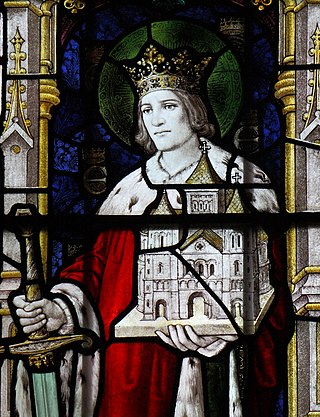Related Research Articles

Year 616 (DCXVI) was a leap year starting on Thursday of the Julian calendar. The denomination 616 for this year has been used since the early medieval period, when the Anno Domini calendar era became the prevalent method in Europe for naming years.
Cadafael ap Cynfeddw was King of Gwynedd. He came to the throne when his predecessor, King Cadwallon ap Cadfan, was killed in battle, and his primary notability is in having gained the disrespectful sobriquet Cadafael Cadomedd.
Cadfan ap Iago was King of Gwynedd. Little is known of the history of Gwynedd from this period, and information about Cadfan and his reign is minimal.
Iago ap Beli was King of Gwynedd. Little is known of him or his kingdom from this early era, with only a few anecdotal mentions of him in historical documents.
Beli ap Rhun was King of Gwynedd. Nothing is known of the person, and his name is known only from Welsh genealogies, which confirm that he had at least two sons. He succeeded his father Rhun ap Maelgwn as king, and was in turn succeeded by his son Iago. Beli was either the father or grandfather of Saint Edeyrn.
Idwal Iwrch, or Idwal ap Cadwaladr, is a figure in the genealogies of the kings of Gwynedd. He was the son of King Cadwaladr ap Cadwallon and the father of King Rhodri Molwynog. William Wynne places Cynan Dindaethwy as his son, but other sources have Cynan as the son of Rhodri. The records of this era are scanty, and Idwal's name appears only in the pedigrees of later kings and in a prophecy found in two 14th-century Welsh manuscripts, which says that he will succeed his father Cadwaladr as king.

Rhodri Molwynog, also known as Rhodri ap Idwal was an 8th-century king of Gwynedd. He was listed as a King of the Britons by the Annals of Wales.

Cynan Dindaethwy or Cynan ap Rhodri was a king of Gwynedd in Wales in the Early Middle Ages. Cynan was the son of Rhodri Molwynog and ascended to the throne of Gwynedd upon the death of King Caradog ap Meirion in 798. His epithet refers to the commote of Dindaethwy in the cantref Rhosyr. Unlike later kings of Gwynedd, usually resident at Aberffraw in western Anglesey, Cynan maintained his court at Llanfaes on the southeastern coast. Cynan's reign was marked by a destructive dynastic power struggle with a rival named Hywel, usually supposed to be his brother.
Merfyn Frych, also known as Merfyn ap Gwriad and Merfyn Camwri, was King of Gwynedd from around 825 to 844, the first of its kings known not to have descended from the male line of King Cunedda.

Hywel ap Rhodri Molwynog was King of Gwynedd. He rose to power following a destructive dynastic struggle in which he deposed his brother, King Cynan Dindaethwy ap Rhodri. During Hywel's reign Gwynedd's power was largely confined to Anglesey. It was a time of substantial territorial loss to Mercia.
Brochwel son of Cyngen, better known as Brochwel Ysgithrog, was a king of Powys in eastern Wales. The unusual epithet Ysgithrog has been translated as "of the canine teeth", "the fanged" or "of the tusk".

Brycheiniog was an independent kingdom in South Wales in the Early Middle Ages. It allied with the Mercian kingdom in the post Roman era, to stabilise and control a central (Marches) area key to dominance over central Proto-England to the east and the south Welsh kingdom of Deheubarth to the west. It was conquered and pacified by the Armorican Normans between 1088 and 1095, though it remained Welsh in character. It was transformed into the Lordship of Brecknock and later formed the southern and larger part of the historic county of Brecknockshire. To its south was the Kingdom of Morgannwg.
Cynan Garwyn was king of Powys in the north-east and east of Wales, who flourished in the second half of the 6th century. Little reliable information exists which can be used to reconstruct the background and career of the historical figure. Available materials include early Welsh poetry, genealogies and hagiography, which are often late and of uncertain value.
Manwgan ap Selyf was an early 7th-century King of Powys, the son of Selyf Sarffgadau.
Eiludd Powys was an early 7th-century King of Powys.

The Royal House of Mathrafal began as a cadet branch of the Welsh Royal House of Dinefwr, taking their name from Mathrafal Castle, their principal seat and effective capital. They effectively replaced the House of Gwertherion, who had been ruling the Kingdom of Powys since late Roman Britain, through the politically advantageous marriage of an ancestor, Merfyn the Oppressor. King Bleddyn ap Cynfyn would join the resistance of the Anglo-Saxon King Harold Godwinson, against the invasion of William the Conqueror, following the Norman conquest of England. Thereafter, they would struggle with the Plantagenets and the remaining Welsh Royal houses for the control of Wales. Although their fortunes rose and fell over the generations, they are primarily remembered as Kings of Powys and last native Prince of Wales.
Gwriad ap Elidyr or Gwriad Manaw was a late-8th century figure in Wales. Very little is known of him, and he chiefly appears in the historical record in connection to his son Merfyn Frych, King of Gwynedd from around 825 to 844 and founder of the Merfynion dynasty.
Selyf is a Welsh male given name. It may refer to:
References
- Kari Maund (2000) The Welsh Kings: The Medieval Rulers of Wales (Tempus)
- Jesus College Ms.18